Introduction
Artificial Intelligence (AI) is no longer just a futuristic idea, it's essential to thriving businesses today. AI agents, sophisticated software capable of autonomous actions and adaptive learning, are at the heart of this transformation. Leveraging AI agent frameworks can streamline operations, significantly enhance customer experiences, and position your enterprise at the forefront of technological innovation.
What Are AI Agents?
AI agents are autonomous systems that interact with their environment, making decisions and performing tasks independently to achieve specific goals. They utilize advanced algorithms, learning continuously from interactions and data to enhance their decision-making capabilities. These agents can significantly improve operational efficiency and responsiveness, driving substantial value across various business applications. By 2025, 90% of hospitals are expected to adopt AI agents to improve predictive analytics and patient outcomes.
Why Are AI Agents Important in Modern Applications?
AI agents play a crucial role in modern applications by automating complex processes, enhancing user experiences, and enabling real-time adaptive decision-making. Their importance lies in their ability to manage vast amounts of data, learn continuously, and perform sophisticated analyses that exceed human capabilities. As businesses navigate increasingly complex technological landscapes, AI agents become essential in maintaining competitive advantage through efficiency and innovation.
Understanding AI Agent Frameworks
AI agent frameworks offer foundational structures that simplify the creation, deployment, and management of intelligent software. By eliminating extensive groundwork, these frameworks allow businesses to focus directly on customizing solutions tailored to specific needs.
What Are AI Agent Frameworks?
AI agent frameworks are comprehensive platforms composed of libraries, tools, and design patterns specifically created for building intelligent, autonomous agents. These frameworks encapsulate common functionalities such as decision logic, environment interaction, memory storage, and communication protocols. By offering pre-configured components, they reduce the need to reinvent foundational systems, allowing developers to concentrate on higher-level tasks like custom logic and integrations.
Key benefits include
- Rapid development and deployment.
- Reduced complexity through foundational coding.
- Enhanced reliability through tested components.
Why Use a Framework Instead of Building From Scratch?
Developing AI agents from the ground up can be an intensive and resource-heavy endeavor, often requiring a deep bench of specialized talent and extended timeframes. This approach can delay time-to-market and increase operational risk, especially for organizations new to AI. Instead, using a proven AI framework allows teams to build on top of established foundations, speeding up development while leveraging the collective insights of the broader developer community.
Frameworks come with multiple advantages
- Accelerated implementation timelines.
- Cost reduction through established, reliable tools.
- Reduced operational risks with proven methodologies.
By opting for a pre-built framework, businesses not only streamline development but also gain access to best practices, community support, and tools that ensure scalability, reliability, and long-term maintainability.
Should You Use an AI Agent Framework?
Do You Need One?
Assessing your specific needs is crucial. Consider factors like operational complexity, resource availability, and desired scalability to determine if an AI framework aligns with your strategic objectives.
How to Evaluate and Choose the Right One
Evaluate frameworks based on compatibility, ease of implementation, scalability, and community support. A thorough assessment ensures optimal alignment with your business goals and operational requirements.
Decision-Making Checklist Based on Your Use Case
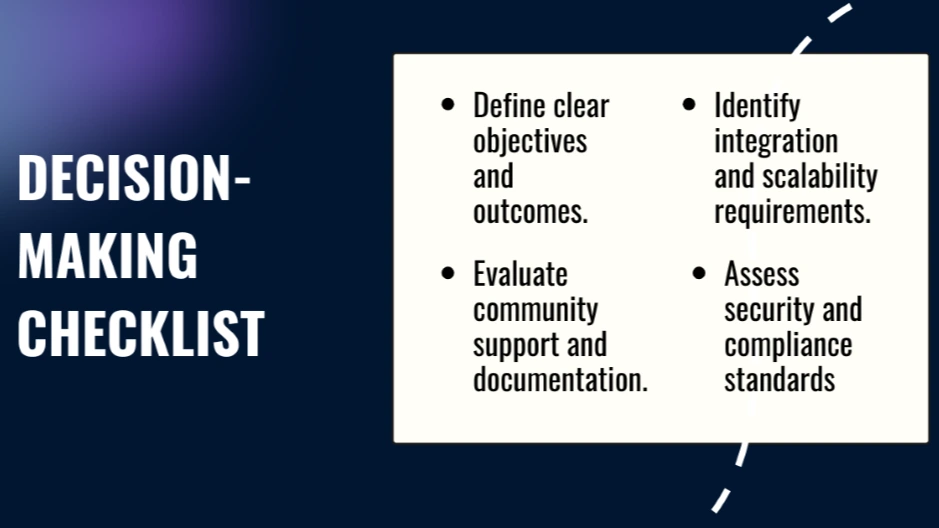
Empower your enterprise with Robylon’s adaptable, outcome-driven AI agents. Discover how Robylon can revolutionize your operations today.
Core Capabilities of a Modern AI Agent Framework
Modern frameworks deliver extensive capabilities essential for enterprise-level AI solutions. These features support businesses in optimizing their operations through efficient and scalable intelligent systems.
- Advanced decision-making logic
- Adaptive learning algorithms
- Seamless integration capabilities
- Comprehensive monitoring and observability
- Multi-agent collaboration support
Popular Frameworks and Why They Matter
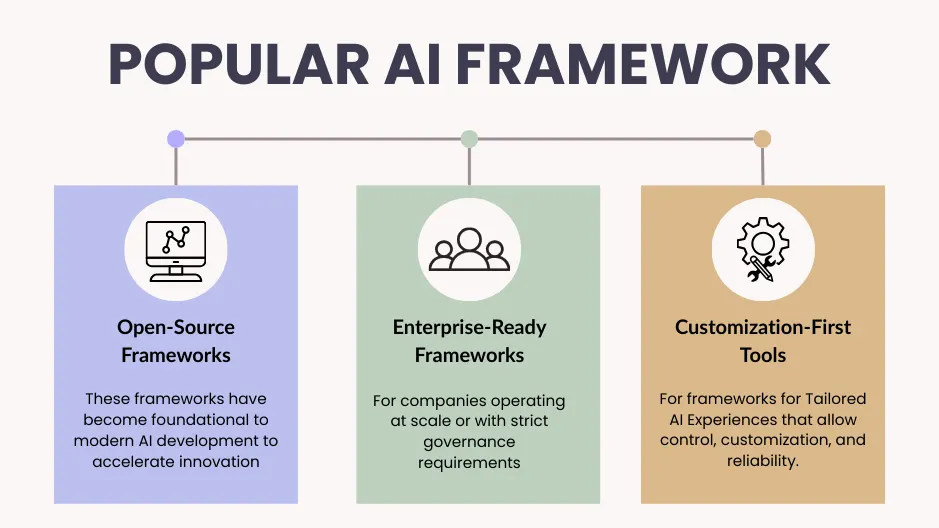
The AI framework you choose can deeply impact how effectively your solution scales, integrates, and delivers business value. Frameworks vary in their focus, some are built for rapid prototyping and experimentation, while others are optimized for secure enterprise integration or complex orchestration across tools.
Below is a breakdown of commonly used frameworks in 2025, categorized by function and business relevance.
1. Open-Source Frameworks Accelerating Innovation
Open-source AI frameworks have become foundational to modern AI development, especially for startups, researchers, and teams focused on speed and flexibility. These tools are known for fostering community collaboration, faster iteration cycles, and cost-effective experimentation.
According to a 2025 industry survey, over 50% of organizations leverage open-source AI tools to power internal LLM applications, automation workflows, and data pipelines.
Popular open-source frameworks include
- LangChain – Chain together LLM tasks like search, retrieval, and summarization. Ideal for building multi-step applications like AI agents or RAG systems.
- CrewAI – A framework that helps build collaborative multi-agent systems for more complex, parallelized reasoning tasks.
- Auto-GPT – One of the earliest autonomous agents, used to demonstrate complex task planning and execution using GPT models.
- Voiceflow – A visual interface and logic builder for designing voice and conversational AI apps.
These frameworks are especially valuable for
- Rapid prototyping and testing new ideas
- Automating multi-step LLM workflows
- Building lightweight, cost-effective tools with minimal infrastructure
2. Enterprise-Ready Frameworks for Large-Scale Integration
For companies operating at scale or with strict governance requirements, enterprise-focused frameworks offer better security, integration, and orchestration.
One of the most prominent
- Microsoft’s Semantic Kernel – Designed to help enterprises build AI agents that integrate with internal systems (CRMs, ERPs, etc.). It enables advanced task planning, memory persistence, and secure plugin execution.
Key advantages of Semantic Kernel
- Seamless integration with Microsoft Azure and enterprise APIs
- Advanced orchestration for complex tasks across distributed systems
- Scalable architecture suitable for IT-controlled environments
This framework is ideal for mid-market to large enterprises looking to embed AI into existing software and business workflows securely.
3. Customization-First Tools for Tailored AI Experiences
Sometimes, out-of-the-box frameworks aren't enough. Businesses with domain-specific use cases,legal, finance, healthcare, need frameworks that allow for high levels of control, customization, and reliability.
Two tools that support this include
- LlamaIndex (formerly GPT Index): A framework designed for building retrieval-augmented generation (RAG) systems. It enables developers to connect LLMs to structured and unstructured data sources for context-aware responses.
- Pydantic: A data validation library often used in AI pipelines to ensure that inputs and outputs are structured correctly. Especially helpful when building dependable, production-grade LLM applications.
Customization frameworks like these are most useful when
- Domain-specific accuracy and compliance are critical
- You're integrating AI into existing product logic
- You need to manage or validate structured data formats
4. Feature Trade-Offs: Comparing Frameworks by Use Case
When selecting the right framework, it’s not about “best overall”, it’s about best for your needs. Here’s how some common priorities stack up.
Key trade-offs to evaluate
- Ease of use vs. flexibility – Do you want no-code speed or custom-code control?
- Integration compatibility – Will it work with your tech stack out of the box?
- Scalability needs – Are you building a POC or something production-ready?
Key Considerations When Choosing an AI Agent Framework
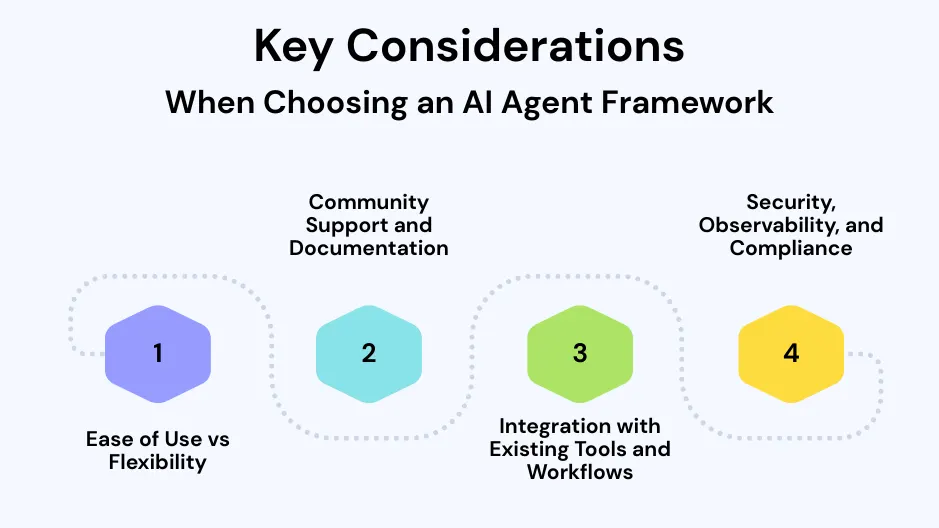
Strategically selecting an appropriate AI framework involves evaluating usability, integration ease, support availability, and security. Careful consideration ensures successful implementation and optimal results.
1. Ease of Use vs Flexibility
Choosing between ease of use and flexibility depends on your organization's specific needs and capabilities. Frameworks that are easy to adopt can be implemented quickly, providing immediate productivity benefits. However, flexible frameworks offer deeper customization, accommodating complex requirements and future changes.
- Quick adoption advantages.
- Opportunities for deeper, more complex customizations.
Organizations must assess their technical capabilities and long-term objectives to choose the best balance between simplicity and adaptability.
2. Community Support and Documentation
Robust community support and clear documentation greatly enhance the effectiveness and ease of adopting an AI framework. Strong community backing facilitates faster problem-solving, especially crucial during initial implementation stages.
- Facilitates faster problem-solving.
- Enhances the ease and effectiveness of implementation.
Good documentation reduces learning curves and ensures teams can efficiently leverage all framework features.
3. Integration with Existing Tools and Workflows
Efficient integration with your existing tools and workflows ensures minimal disruption during AI framework adoption. A seamless transition is essential to maintain productivity and operational continuity.
- Minimizes disruption during adoption.
- Improves overall system efficiency.
Selecting a compatible framework helps achieve immediate operational benefits while maximizing return on existing technology investments.
4. Security, Observability, and Compliance
Maintaining security, observability, and compliance is critical when deploying AI frameworks. Protecting sensitive information and ensuring regulatory compliance prevents risks and potential liabilities.
- Essential for safeguarding sensitive data.
- Ensures compliance with regulatory requirements.
Organizations should prioritize frameworks with robust security measures, clear visibility tools, and comprehensive compliance standards to mitigate operational and legal risks effectively.
FAQs
What are the ethical considerations of using pre-built versus custom AI agents?
Custom AI agents offer enhanced ethical control and transparency, minimizing risks associated with pre-built, less transparent alternatives. Custom solutions allow businesses to explicitly align their AI implementations with their ethical standards and operational goals. Conversely, pre-built agents may introduce unintended biases or ethical risks due to limited transparency and oversight during their development.
What is Microsoft’s Semantic Kernel, and how does it integrate AI into businesses?
Microsoft’s Semantic Kernel seamlessly integrates AI into enterprise workflows, automating complex processes and enhancing business decision-making. This framework provides robust automation tools, enabling organizations to streamline routine operations and leverage AI-driven analytics effectively. Its ability to integrate effortlessly with existing systems ensures minimal disruption and maximizes operational efficiency.
How do multi-agent systems enhance AI collaboration?
Multi-agent systems enable multiple AI agents to collaborate effectively, significantly enhancing productivity, adaptability, and decision-making capabilities. These systems facilitate the division and coordination of complex tasks, allowing agents to operate autonomously yet collaboratively towards shared goals. Consequently, organizations can manage sophisticated operations more efficiently and adapt rapidly to dynamic environments.
What are open-source AI frameworks, and why are they important?
Open-source AI frameworks democratize technology, fostering innovation and collaboration by providing accessible and cost-effective AI solutions. They allow developers worldwide to contribute to and benefit from collective advancements, significantly accelerating development processes. This openness promotes transparency, flexibility, and rapid improvement of AI technologies.








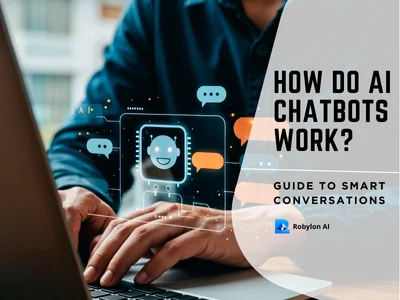
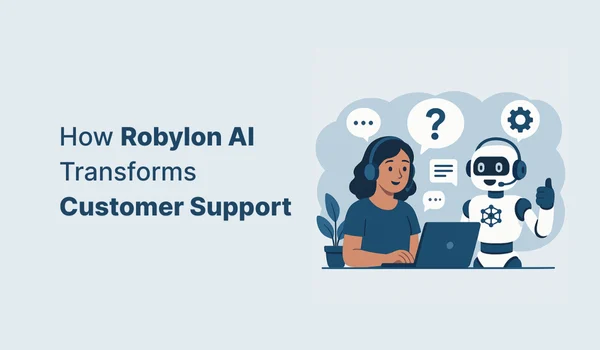
.png)
.webp)













